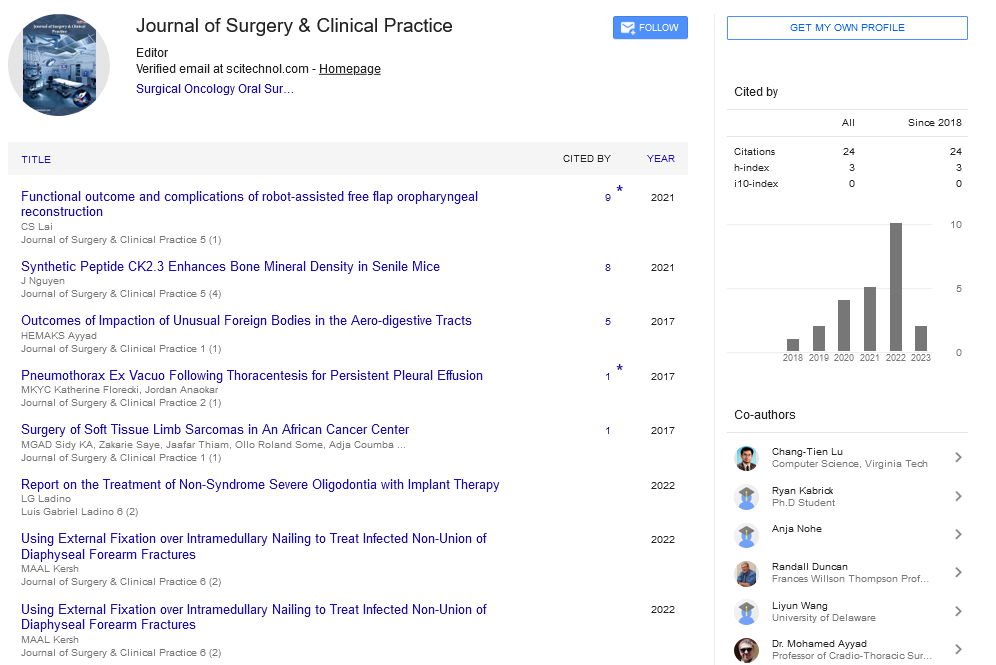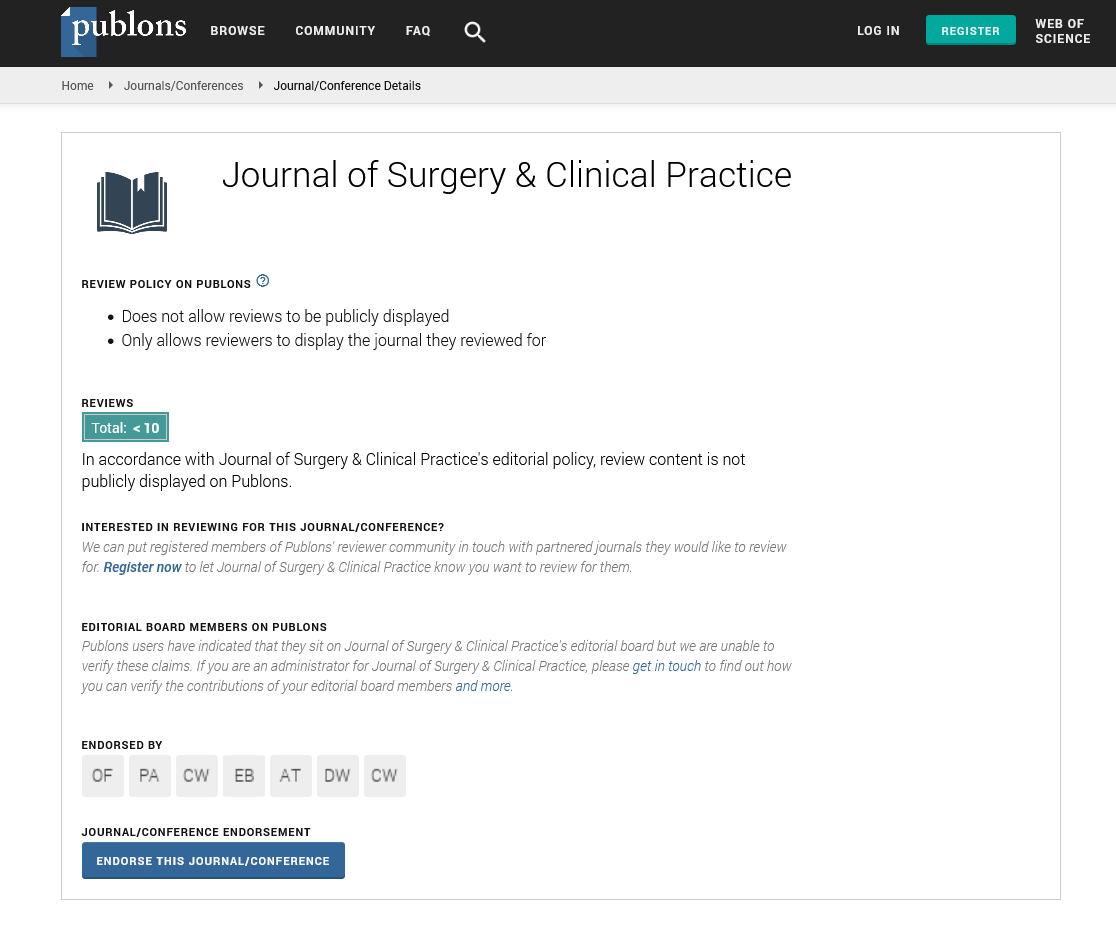Short Communication, J Surg Clin Prac Vol: 7 Issue: 1
Effective Pain Management Strategies during Surgery
Lukas Rasulic*
1Department of Surgery, Clinical Center of Serbia, Belgrade, Serbia
*Corresponding Author: Lukas Rasulic
Department of Surgery, Clinical Center of Serbia, Belgrade, Serbia
E-mail: lukas@gmail.com
Received date: 22 February, 2023, Manuscript No. JSCP-23-93035;
Editor assigned date: 27 February, 2023, Pre QC No. JSCP-23-93035(PQ);
Reviewed date: 15 March, 2023, QC No. JSCP-23-93035;
Revised date: 22 March, 2023, Manuscript No: JSCP-23-93035(R);
Published date: 29 March, 2023, DOI: 10.35248/JSCP.23.7.100366.
Citation: Rasulic L (2023) Effective Pain Management Strategies during Surgery. J Surg Clin Prac 7:1.
Description
Pain management during surgery is a crucial aspect of patient care. Surgery can cause pain and discomfort, which can negatively impact the patient's overall experience and recovery. Effective pain management can help reduce the risk of complications, improve patient outcomes, and increase patient satisfaction [1-3]. There are several methods of pain management that may be used during surgery, including general anesthesia, regional anesthesia, local anesthesia, patient-controlled analgesia and medications such as opioids and nonopioids. General anesthesia is the most common method of pain management during surgery. It involves the use of medications to put the patient into a deep sleep and prevent them from feeling pain during the procedure.
General anesthesia is typically administered through an IV (Intravenously) or by breathing in gas through a mask [4,5]. During general anesthesia, the patient is closely monitored by an anesthesiologist. The anesthesiologist adjusts the medications to ensure the patient remains asleep and does not experience pain during the surgery. Once the surgery is complete, the anesthesiologist gradually reduces the medications, allowing the patient to wake up slowly. Regional anesthesia involves the injection of medication into a specific area of the body to numb the nerves and prevent pain. Examples of regional anesthesia include epidural anesthesia, spinal anesthesia, and nerve blocks [6].
Epidural anesthesia involves the injection of medication into the epidural space, which is the area surrounding the spinal cord. The medication numbs the nerves in the lower part of the body, providing pain relief during lower abdominal, pelvic, and leg surgeries. Epidural anesthesia is also commonly used during childbirth to manage labor pain. Spinal anesthesia involves the injection of medication directly into the spinal fluid. This method provides pain relief from the waist down and is commonly used for lower abdominal and leg surgeries [7-9]. Nerve blocks involve the injection of medication around a specific nerve or group of nerves to provide pain relief to a specific area of the body. Nerve blocks are commonly used for surgeries involving the limbs, such as hand, arm, foot, or leg surgeries. Local anesthesia involves the injection of medication into a small area of the body to numb the nerves and prevent pain. Local anesthesia is often used for minor procedures or surgeries, such as dental work or skin biopsies. The medication is injected directly into the area being treated, and the patient remains awake during the procedure.
Patient-Controlled Analgesia involves the use of a device that allows the patient to self-administer pain medication through an IV. The patient can control the amount of medication they receive, which can help improve pain management and reduce the risk of side effects. These devices are programmed by a healthcare provider to deliver a specific dose of medication over a set period of time. The patient can also push a button to receive an additional dose of medication if they are experiencing breakthrough pain. PCA devices are commonly used after surgery to manage pain during the recovery period. The device can be used in conjunction with other pain management methods, such as opioids and non-opioids [10].
Non-opioid medications are often used in combination with opioids to help manage pain during surgery. Non-opioid medications include acetaminophen, Nonsteroidal Anti-Inflammatory Drugs (NSAIDs), and local anesthetics. Acetaminophen is a pain reliever that is often used in combination with opioids to help reduce the amount of opioid medication needed. NSAIDs, such as ibuprofen and aspirin, are also used to help reduce pain and inflammation. Local anesthetics, such as lidocaine, can be injected into a specific area of the body to provide pain relief during surgery [11].
References
- Sprouse-Blum AS, Smith G, Sugai D, Parsa FD (2010) Understanding endorphins and their importance in pain management. Hawaii J Med Public Health 69:70.
[Google Scholar] [PubMed]
- Breivik H (1998) Postoperative pain management: Why is it difficult to show that it improves outcome? Eur J Anaesthesiol 15:748-751.
- Bonnet F, Marret E (2007) Postoperative pain management and outcome after surgery. Best Pract Res Clin Anaesthesiol 21:99-107.
[Crossref] [Google Scholar] [PubMed]
- Bonnet F, Marret E (2007) Postoperative pain management and outcome after surgery. Best Pract Res Clin Anaesthesiol 21:99-107.
- Morad A, Farrokh S (2018) Essentials of Anesthesia for Neurotrauma. Res Clin Anaesthesiol 447-460.
- Shoar S, Esmaeili S, Safari S (2012) Pain management after surgery: A brief review. Anesth Pain Med 1:184.
[Crossref] [Google Scholar] [PubMed]
- Friesner SA, Curry DM, Moddeman GR (2006) Comparison of two pain-management strategies during chest tube removal: Relaxation exercise with opioids and opioids alone. Heart Lung Circ 35:269-276.
[Crossref] [Google Scholar] [PubMed]
- Yorke J, Wallis M, McLean B (2004) Patients perceptions of pain management after cardiac surgery in an Australian critical care unit. Heart Lung Circ 33:33-41.
[Google Scholar] [PubMed]
- Dion L, Rodgers N (2011) Effect of massage on pain management for thoracic surgery patients. Int J Ther Massage Bodywork 4:2. [Crossref]
[Google Scholar] [PubMed]
- Gandhi K (2011) Challenges in acute pain management. Anesthesiol Clin 29:291-309.
- Fletcher D, Fermanian C, Mardaye A, Aegerter P (2008) A patient-based national survey on postoperative pain management in France reveals significant achievements and persistent challenges. Pain 137:441-451.
 Spanish
Spanish  Chinese
Chinese  Russian
Russian  German
German  French
French  Japanese
Japanese  Portuguese
Portuguese  Hindi
Hindi 
